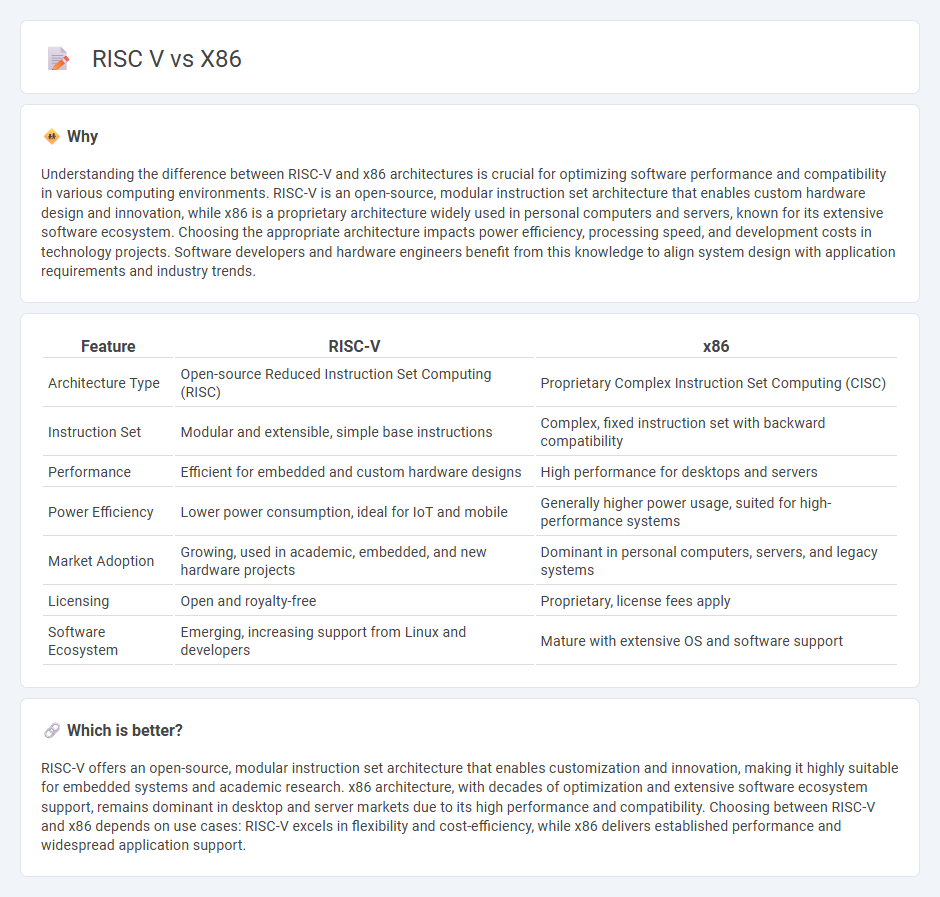
RISC-V and x86 represent two distinct CPU architectures with RISC-V offering an open-source, modular design that supports customization and energy efficiency, while x86 provides a mature, widely adopted architecture known for high performance and extensive software compatibility. RISC-V's increasing adoption in embedded systems and innovation-driven applications contrasts with x86's dominance in personal computers and servers. Explore further to understand how these architectures influence computing futures.
Why it is important
Understanding the difference between RISC-V and x86 architectures is crucial for optimizing software performance and compatibility in various computing environments. RISC-V is an open-source, modular instruction set architecture that enables custom hardware design and innovation, while x86 is a proprietary architecture widely used in personal computers and servers, known for its extensive software ecosystem. Choosing the appropriate architecture impacts power efficiency, processing speed, and development costs in technology projects. Software developers and hardware engineers benefit from this knowledge to align system design with application requirements and industry trends.
Comparison Table
| Feature | RISC-V | x86 |
|---|---|---|
| Architecture Type | Open-source Reduced Instruction Set Computing (RISC) | Proprietary Complex Instruction Set Computing (CISC) |
| Instruction Set | Modular and extensible, simple base instructions | Complex, fixed instruction set with backward compatibility |
| Performance | Efficient for embedded and custom hardware designs | High performance for desktops and servers |
| Power Efficiency | Lower power consumption, ideal for IoT and mobile | Generally higher power usage, suited for high-performance systems |
| Market Adoption | Growing, used in academic, embedded, and new hardware projects | Dominant in personal computers, servers, and legacy systems |
| Licensing | Open and royalty-free | Proprietary, license fees apply |
| Software Ecosystem | Emerging, increasing support from Linux and developers | Mature with extensive OS and software support |
Which is better?
RISC-V offers an open-source, modular instruction set architecture that enables customization and innovation, making it highly suitable for embedded systems and academic research. x86 architecture, with decades of optimization and extensive software ecosystem support, remains dominant in desktop and server markets due to its high performance and compatibility. Choosing between RISC-V and x86 depends on use cases: RISC-V excels in flexibility and cost-efficiency, while x86 delivers established performance and widespread application support.
Connection
RISC-V and x86 are connected through their roles as fundamental instruction set architectures (ISAs) in modern computing, with RISC-V offering an open-source alternative to the proprietary x86 architecture developed by Intel and AMD. Both architectures define the rules for software-hardware interaction, enabling efficient processing and execution of machine instructions in CPUs. The growing adoption of RISC-V in embedded systems and the open hardware community challenges x86's dominance in personal computing and servers.
Key Terms
Instruction Set Architecture (ISA)
x86 features a Complex Instruction Set Computing (CISC) architecture with variable-length instructions that optimize backward compatibility and rich instruction sets for versatile computation. RISC-V, a Reduced Instruction Set Computing (RISC) architecture, emphasizes simplicity and modularity with fixed-length instructions, enhancing efficiency and ease of implementation in modern processors. Explore the detailed comparison of x86 and RISC-V ISAs to understand their impact on processor performance and design.
Compatibility
x86 architecture dominates the computing landscape due to its extensive backward compatibility with decades of software, ensuring seamless execution of legacy applications across personal computers and servers. RISC-V, as an open-standard instruction set architecture, promotes flexibility and customization but faces challenges in software compatibility, requiring emulation or recompilation for many existing x86 binaries. Explore the technical and practical implications of compatibility between x86 and RISC-V architectures to make informed hardware and software decisions.
Source and External Links
x86 - Wikipedia - x86 is a family of complex instruction set computer (CISC) architectures initially developed by Intel, based on the 8086 microprocessor, and remains dominant in most desktop and laptop computers.
x86-64 - Wikipedia - x86-64 is a 64-bit extension of the x86 instruction set, introduced by AMD, enabling compatibility with both 16/32-bit legacy applications and new 64-bit software, adopted widely in modern PCs and servers.
Everything You Need To Know About X86 - Lenovo - x86 CPUs, known for CISC design and backward compatibility, power the majority of personal computers and servers, with well-known examples including Intel's Core i series and AMD's Ryzen and Athlon processors.
 dowidth.com
dowidth.com